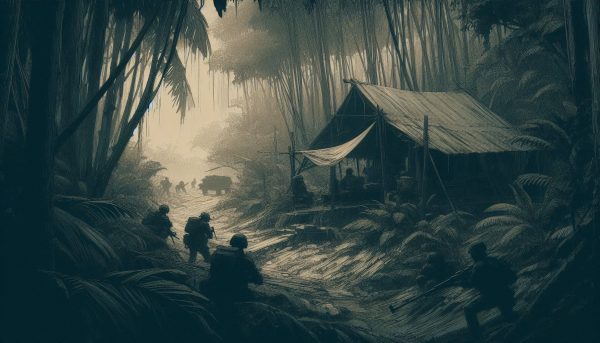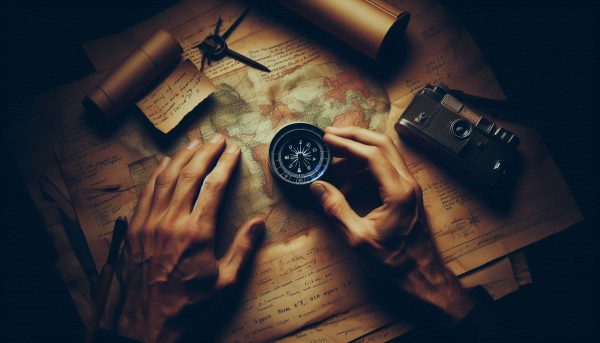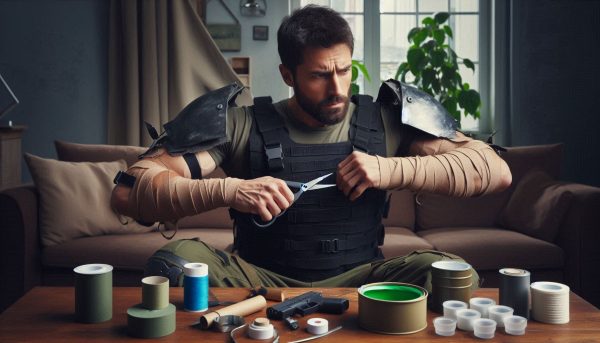In the covert world of intelligence, few individuals navigate the depths of danger and geopolitical intrigue with the unwavering resolve of a genuine ‘shadow warrior’. This is the story of a man whose life has been inextricably linked with the Central Intelligence Agency (CIA), from the front lines of Cold War conflicts to the nerve centre of counter-terrorism operations. His journey, marked by extraordinary experiences and profound insights, offers a rare glimpse into the sacrifices and strategies employed to safeguard national interests from the unseen threats lurking in the global landscape.
Forged in Uniform: From Pararescue to Special Operations Exposure
Before joining the ranks of the clandestine service, the operative carved out a distinguished career in the US Air Force’s Pararescue, an elite special operations force. His path into this demanding field was almost serendipitous, a testament to the powerful influence of the James Bond films he so admired. He later discovered that a colleague in his unit was one of the very ‘guys in the orange suits’ featured in the Thunderball film, cementing a deeply personal connection to his role.
“I was in Pararescue until ’76,” he states, describing the rigorous training that equipped him with combat diving skills learned at the Naval Underwater Swimming School in Key West. Post-Vietnam, with military downsizing impacting his active duty opportunities, he transitioned to the reserves, joining the 20th Special Forces Group. Though he never completed the full ‘Q course’ to become a Green Beret, he gained invaluable exposure through programs like ‘Blue Light,’ the precursor to the legendary Delta Force.
These experiences provided him with extensive weapons familiarisation, from the AR-15 to the then-standard issue revolvers, and honed his tactical proficiency. His immersion in these elite military environments not only sharpened his skills but also instilled a profound understanding of special operations doctrine, a foundation that would prove indispensable in his subsequent career.
Entering the Shadows: Joining the Agency in the 1980s
His transition to the CIA in 1980 marked a pivotal shift from overt military operations to the covert world of intelligence. At the time, public knowledge of the Agency was largely confined to popular fiction. “All I knew about the agency was what I had read in Bond movies,” he admits. Initially brought on as a contract combat medic for the Special Activities Division (SAD), his full-time recruitment came as President Reagan declared war on communism in Latin America. The Agency desperately needed Spanish-speaking paramilitary officers, a niche he perfectly filled, providing his “back door into a staff position with the agency” in 1981.
The Contra Program: A Virgin Black Op
His very first assignment as a staff officer plunged him headfirst into a ‘virgin program’ – the clandestine effort to train the Contras on the Nicaragua-Honduras border. This was a true ‘Black Op,’ designed to operate with a hidden US hand and presidential deniability. “It was a very minuscule, there was only five of us,” he remembers, highlighting the tight-knit nature of the initial team. For the first 14 months, he was the sole American permitted in the Contra camps, a testament to the trust placed in him and the highly sensitive nature of the operation.
“It was sobering and it was very quick, but it was also heaven for me,” he reflects. At 30, brimming with “piss and vinegar,” he was training individuals to fight the same ‘monster’ that had devastated his own family and country. The motivation was deeply personal for the Contras too. As he observed, their reasons were visceral: “They killed my priest and burned my church, they raped my daughter, they forced conscripted my 15-year-old son.” Their fight was not ideological, but a direct response to tangible injustices, a purity of purpose that resonated deeply with his own experiences under communism.
Beyond the training, the operational scope expanded. His pararescue diving skills proved invaluable when headquarters demanded a ‘left hook’ to disrupt Cuban military aid. He devised a daring plan to train local Mosquitos (indigenous people) as combat divers, culminating in a successful operation to blow up Puerto Cabezas’ pier – the “belly button for Cuban military aid into Nicaragua.” This covert blow, later confirmed by satellite imagery, was a significant victory in the shadows.

Lessons from Bay of Pigs: Politics vs. Operations
His time at the Agency provided him with a unique vantage point on historical operations, none more infamous than the Bay of Pigs. He engaged in extensive conversations with veterans of the operation, including Felix Rodriguez, a key figure in the pre-invasion efforts. The overwhelming lesson learned from this debacle, he asserts, was the catastrophic consequence of allowing political considerations to derail special operations. “You cannot run Special Operations through a political optic,” he states emphatically.
Evolving the Agent: Paramilitary Meets Case Officer
After three years on the front lines in Central America, the Agency sponsored his return to George Mason University to complete his four-year degree, a prerequisite for formal tradecraft training at ‘The Farm’ in early 1985. His initial experience at CIA Headquarters was nothing short of surreal. “My feet were literally not touching the ground,” he describes, recalling the awe of seeing the Wall of Stars.
The Farm itself was an immersive experience, meticulously designed to replicate a foreign country. Here, he underwent four intense months of direct training, learning the intricacies of tradecraft: surveillance detection, film development, and the full recruitment cycle. Crucially, the Agency mandated that all paramilitary officers seeking promotion had to undergo case officer training. “We’re not the central Airborne agency, we’re the Central Intelligence Agency,” was the driving philosophy. He excelled, seamlessly merging his ‘knuckle-dragger’ paramilitary skills with the nuanced art of human intelligence.
This dual capability was immediately put to the test in Costa Rica, where he was tasked with running the southern front against the Sandinistas. It was a stark departure from his previous role. “Here I am, you know, my first three years I’m all gunned up… and now I’m in suit and tie working out of an embassy as a third secretary… and running the program from the south,” he explains. This experience honed his tradecraft, forcing innovation. They conducted meetings in a mobile, air-conditioned van, meeting Contra commanders covertly to avoid detection by hostile Costa Rican authorities. This adaptability, he stresses, was key.

A Global Agent: From Manila to Khartoum
His career continued to span global hotspots, taking him to the Philippines in 1990 where he ran the liaison shop, working against the New People’s Army (NPA) and the Abu Sayyaf Group. It was a turbulent period, following the assassination of US Army Special Forces Colonel Nick Rowe. In this volatile environment, he encountered the notorious ‘Sparrow Assassins.’
Navigating Danger in the Philippines
The Sparrows, a group of NPA assassins, employed a chillingly precise modus operandi. They carried a .45 calibre 1911 A1 pistol in their crotch, hammer back, grip safety taped down, and would, in a lightning-fast motion, push the gun up to shoot their target in the head, then disappear. He vividly recounts a near-fatal encounter in Davao. Leaving a restaurant with two Filipino Green Berets and a fellow case officer, he noticed three men approaching them. “When they saw us, they got three abreast, started walking towards front of us. The guys at the end all had their hands in the left pocket.”
His instincts, honed by years of training, screamed danger. In an instant, he drew his own .45, the loudest click he’d ever heard. The Sparrows didn’t flinch, their eyes locked on. “If you’re walking down the street and somebody pulls out a gun at you, you’re at least going to do this,” he gestures, “these guys didn’t even blink.” This chilling composure was their signature. “Awareness beats fast draw every single time,” he states, a profound lesson he now imparts in post-Agency training. Had he and his colleague not reacted instantly, they wouldn’t have survived.
The Bin Laden Task Force: A Race Against Time
A pivotal chapter in his career began in January 1996 when he co-founded the Bin Laden Task Force. This new ‘virtual station’ in the DC area was a groundbreaking concept, a dedicated unit to track the emerging threat of Osama bin Laden. As the Deputy Chief of Station and Senior Ops Officer, he oversaw a small cadre of analysts and an FBI liaison.
“When we started we had maybe two or three thick files on him, a year later we had ten files,” he recounts. They diligently collected intelligence, both unilateral and liaison, confirming Bin Laden was recruiting and training radicalised individuals in camps. They even had overhead satellite imagery. “It was very rewarding to see what we were able to put together, the concepts for disrupting him,” he recalls.
However, this period was also defined by immense frustration. Despite the growing intelligence and clear warnings, their proposals for kinetic action were repeatedly rejected by the administration. “Every time you go up a flagpole they go no, he hasn’t done anything yet.” The devastating twin embassy bombings in Kenya and Tanzania in 1998 tragically validated their warnings, but by then, he felt, it was too late. Bin Laden had gone to ground.
Learning from Cold Warriors: The OSS Mentality
His true mentors were the Cold Warriors – veterans from the 1950s, 60s, and 70s, including those who had served in Vietnam and even the Bay of Pigs. “I walked in the shadow of giants,” he says, naming figures like Wayne Fisk from Pararescue, and CIA luminaries such as Ray Dozier, Dewey Clarridge, Joe Fernandez, Cofer Black, and Jose Rodriguez. Listening to their stories, he marvelled at what these seasoned operatives “got away with back then. I mean, it was some crazy stuff.”
He advocates for a return to the “OSS mentality” – the ethos of the Office of Strategic Services, the wartime precursor to the CIA. “If it was easy, State Department would be doing it,” was a joking motto in the Agency, underscoring their unique role in undertaking tasks “nobody else is assigned to do.” He champions the full integration of paramilitary and case officer roles, believing there should be no division. “You guys may be great knuckle draggers and meat eaters, but you have to learn the craft,” he quotes, emphasising the importance of intelligence tradecraft for every operative. This holistic approach, he argues, is what truly defines the Central Intelligence Agency.
Today’s Threats: A Veteran’s Perspective
Drawing on decades of experience, the operative offers a stark assessment of current global threats, viewing them through the prism of historical lessons learned and the ongoing challenges faced by intelligence agencies.

A Glimmer of Hope: The Future of Service
Despite the sobering assessment of global threats, the operative remains remarkably hopeful for the future. His optimism stems from a deep-seated belief in divine guidance and the inherent strength of the United States. “I have to remain optimistic,” he affirms, “I do, I have high hopes that this new Administration is going to be a game-changer.” He expresses particular admiration for the calibre of service people and military folks entering leadership roles, believing their firsthand understanding of conflict will lead to more cautious decision-making.
To see the original interview, go to: https://www.youtube.com/watch?v=-zmrWa8gX7I&list=PLbMGpRaM4g3GZ-3KXLqeIeWcaG80oxfDa&index=13




